The AMD Trinity Review (A10-4600M): A New Hope
by Jarred Walton on May 15, 2012 12:00 AM ESTAMD Trinity General Performance
Starting as usual with our general performance assessment, we’ve got several Futuremark benchmarks along with Cinebench and x264 HD encoding. The latter two focus specifically on stressing the CPU while PCMarks will cover most areas of system performance (including a large emphasis on storage) and 3DMarks will give us a hint at graphics performance. First up, PCMark 7 and Vantage:
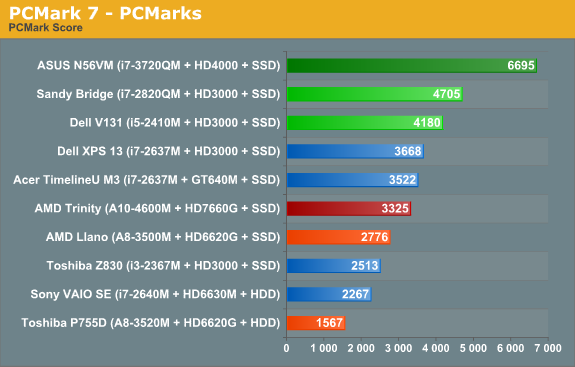
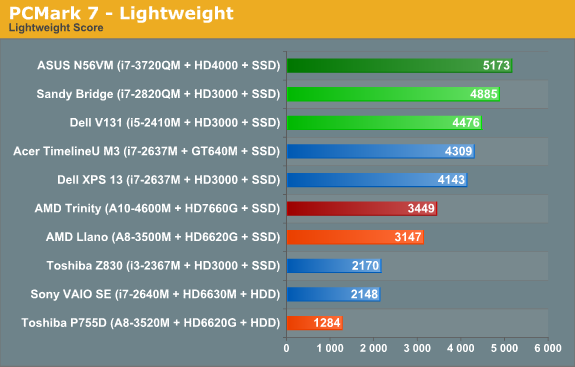
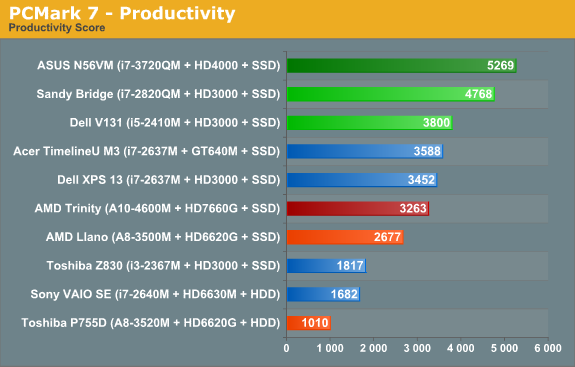

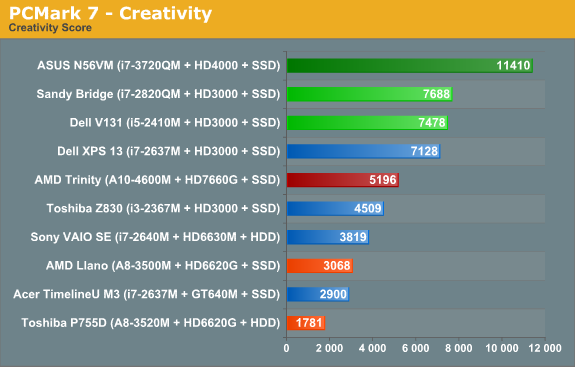
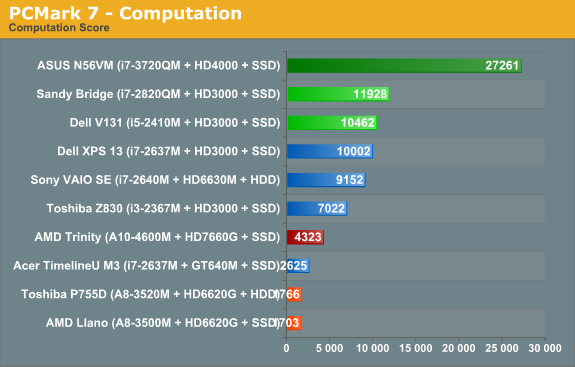
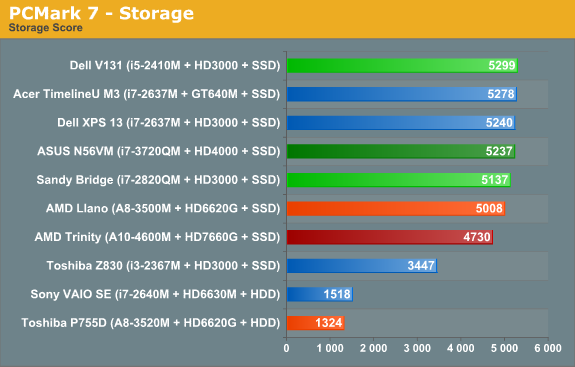
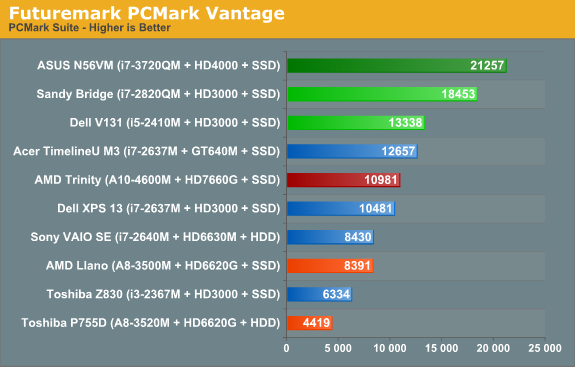
As noted earlier, we ran several other laptops through PCMark 7 and PCMark Vantage testing using the same Intel 520 240GB SSD, plus all the ultrabooks come with SSDs. That removes the SSD as a factor from most of the PCMark comparisons, leaving the rest of the platform to sink or swim on its own. And just how does AMD Trinity do here? Honestly, it’s not too bad, despite positioning within the charts.
Obviously, Intel’s quad-core Ivy Bridge is a beast when it comes to performance, but it’s a 45W beast that costs over $300 just for the CPU. We’ll have to wait for dual-core Ivy Bridge to see exactly how Intel’s latest stacks up against AMD, but if you remember the Llano vs. Sandy Bridge comparisons it looks like we’re in for more of the same. Intel continues to offer superior CPU performance, and even their Sandy Bridge ULV processors can often surpass Llano and Trinity. In the overall PCMark 7 metric, Trinity ends up being 20% faster than a Llano A8-3500M laptop, while Intel’s midrange i5-2410M posts a similar 25% lead on Trinity. Outside of the SSD, we’d expect Trinity and the Vostro V131 to both sell for around $600 as equipped.
A 25% lead for Intel is pretty big, but what you don’t necessarily get from the charts is that for many users, it just doesn’t matter. I know plenty of people using older Core 2 Duo (and even a few Core Duo!) laptops, and for general office tasks and Internet surfing they’re fine. Llano was already faster in general use than Core 2 Duo and Athlon X2 class hardware, and it delivered great battery life. Trinity boosts performance and [spoiler alert!] battery life, so it’s a net win. If you’re looking for a mobile workstation or something to do some hardcore gaming, Trinity won’t cut it—you’d want a quad-core Intel CPU for the former, and something with a discrete GPU for the latter—but for everything else, we’re in the very broad category known as “good enough”.


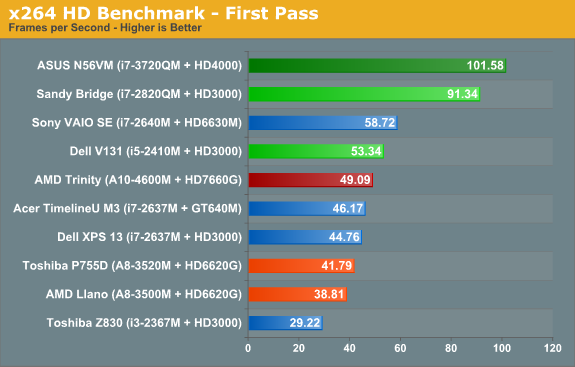
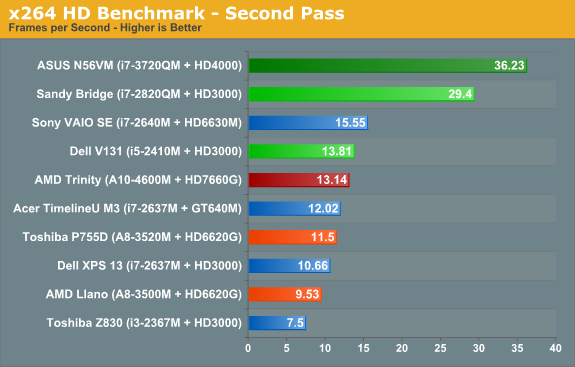
When we start drilling down into other performance metrics, AMD’s CPU performance deficiency becomes pretty obvious. The Cinebench single-threaded score is up 15% from 35W Llano, but in a bit of a surprise the multi-threaded score is basically a wash. Turn to the x264 HD encoding test however and Trinity once again shows a decent 15% improvement over Llano. Against Sandy Bridge and Ivy Bridge, though? AMD’s Trinity doesn’t stand a chance: i5-2410M is 50% faster in single-threaded Cinebench, 27% faster in multi-threaded, and 5-10% faster in x264. It’s a good thing 99.99% of laptop users never actually run applications like Cinebench for “real work”, but if you want to do video encoding a 10% increase can be very noticeable.

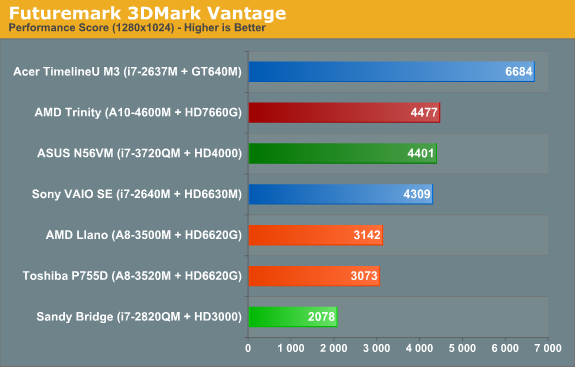
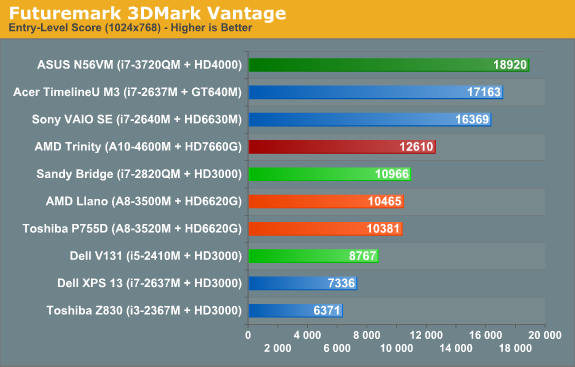
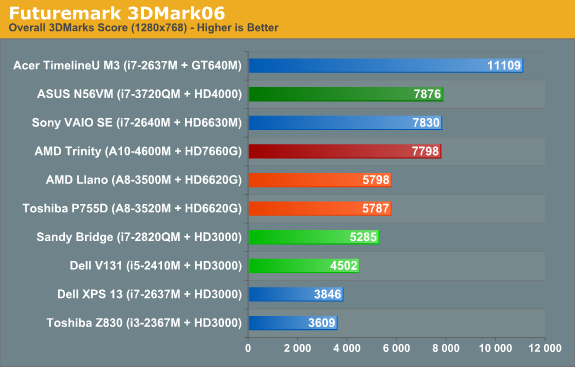
Shift over to graphics oriented benchmarks and the tables turn once again...sort of. Sandy Bridge can’t run 3DMark11, since it only has a DX10 class GPU, but in Vantage Performance and 3DMark06 Trinity is more than twice as fast as HD 3000. Of course, Ivy Bridge’s HD 4000 is the new Intel IGP Sheriff around these parts, and interestingly we see Trinity and i7-3720QM basically tied in these two synthetics. (We’ll just ignore 3DMark Vantage’s Entry benchmark, as it’s so light on graphics quality that we’ve found it doesn’t really stress most GPUs much—even low-end GPUs like HD 3000 score quite well.) We’ll dig into graphics performance more with our gaming benchmarks next.










271 Comments
View All Comments
CeriseCogburn - Thursday, May 24, 2012 - link
And thus anyone who has a laptop already and especially anyone with an old Optimus has no need to spend $700 or $800 on a trinity laptop - just a few bucks on some ram.If they have a lower end MXM discrete they can just upgrade that and not have the hassles of setting up another whole system and spending days transferring data and configuring and then crossing their fingers the amd trinity doesn't glitch out.
We can also forget any sort of "future proofing" with the trinity, unlike the optimus systems or any discrete laptop, many available for a couple hundred less now because their core 2 processors are considered "old" but thanks to you brilliant amd fans we now know it doesn't matter at all might as well get a real laptop gaming machine.
Thanks for the hot tips.
BSMonitor - Tuesday, May 15, 2012 - link
Sure it is. If you browse Flash enhanced, Java runtime pages, Adobe Reader embedded, etc.. Do that and be working in a Java runtime software package, Visual Studio, Office App with a bunch of the fancy tables and drawing tools.It is NOT enough CPU. I would not tolerate it.
Taft12 - Tuesday, May 15, 2012 - link
OK you win. You've convinced us that Trinity is too slow for 1% of users.In other words, you've convinced us that this product is a winner. I just knew you were an AMD fanboi at heart!
Spunjji - Wednesday, May 16, 2012 - link
LOLmedi01 - Thursday, May 17, 2012 - link
Minimized Visual Studio NEEDS NO CPU POWER.Inactive Adobe Reader "embedded" NEEDS NO CPU POWER.
Inactive Office App with tables and what not NEEDS NO CPU POWER.
Miraculous "Java runtime software package" as well as flash would only consume more than a tiny bit of CPU only if it was written by drunken monkeys.
RAM is what you need when multitasking. A lot of it.
And fast HDD.
Slapping SSD hard drive into your pc/notebook would speed mentioned things up tremendously. Faster CPU would not.
kshong - Tuesday, May 15, 2012 - link
I have read many of your comments on AMD and Intel and I have a slight suspicion that you're a hard-to-please person.Spunjji - Tuesday, May 15, 2012 - link
That was putting it kindly. ;)BSMonitor - Tuesday, May 15, 2012 - link
Should I expect a brand new PC to behave like one from 6 years ago for some applications??Spunjji - Wednesday, May 16, 2012 - link
Thing is, it doesn't. Thus your argument fails.Good day to you, sir! :D
mikato - Wednesday, May 16, 2012 - link
Spunjji - Anandtech comments area would like to hire you as the new BS Monitor! We had a problem with the old one.